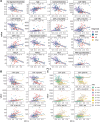Biological signatures in the Alzheimer's continuum discriminate between diagnosis-related and -unrelated associations to ATN categories
- PMID: 40046342
- PMCID: PMC11881062
- DOI: 10.1093/braincomms/fcaf078
Biological signatures in the Alzheimer's continuum discriminate between diagnosis-related and -unrelated associations to ATN categories
Abstract
Alzheimer's disease and related dementias have a multifactorial aetiology and heterogeneous biology. The current study aims to identify different biological signatures in a deeply phenotyped memory clinic patient population. In this cross-sectional study, we analysed 49 pre-specified proteins using a multiplex antibody-based suspension bead array in 278 CSF samples from the real-world research database and biobank at the Karolinska University Hospital Memory Clinic, Solna, Sweden. Patients with a clinical diagnosis of subjective cognitive decline (N = 151), mild cognitive impairment (N = 61), Alzheimer's disease (N = 47), or other diagnoses (N = 19; vascular dementias, alcohol-related dementia, unspecified dementias, or other amnesias) were included. Principal component analyses were performed, and resulting principal components (PCs) were tested for associations with clinical variables and Alzheimer's disease biomarkers (CSF biomarkers beta-amyloid 42, beta-amyloid 42/40, phosphorylated tau 181, phosphorylated tau 181/beta-amyloid 42). PC 1 (explaining 52% of the variance between patients) was associated with the clinical Alzheimer's disease CSF biomarkers beta-amyloid 42, phosphorylated tau 181, and total tau but not with Alzheimer's disease-related neurodegeneration imaging markers, cognitive performance, or clinical diagnosis. PC 2 (explaining 9% of the variance) displayed an inflammatory profile with high contributions of chitinase 3 like 1 (CHI3L1) and triggering receptor expressed on myeloid cells 2 (TREM2) and significant correlation to CSF free light chain kappa. In contrast to PC 1, PC 3 (explaining 5% of the variance) showed associations with all the clinical Alzheimer's disease CSF biomarkers, the imaging markers, cognitive impairment and clinical diagnosis. Serpin family A member 3 (SERPINA3), chitinase 1 (CHIT1), and neuronal pentraxin 2 (NPTX2) contributed most to PC 3. PC 4 (explaining 4% of the variance) exhibited an inflammatory profile distinct from PC 2, with the largest contributions from TREM2, leucine-rich alpha-2-glycoprotein 1 (LRG1) and complement C9. The component was associated with peripheral inflammation. We found that CSF protein profiles in a memory clinic cohort reflect molecular differences across diagnostic groups. Our results emphasize that real-world memory clinic patients can have different ongoing biological processes despite receiving the same diagnosis. In the future, this information could be utilized to identify patient endotypes and uncover precision biomarkers and novel therapeutic targets.
Keywords: Alzheimer's disease; biomarkers; biosignature; cognition; protein profiling.
© The Author(s) 2025. Published by Oxford University Press on behalf of the Guarantors of Brain.
Conflict of interest statement
M.K. has served on scientific advisory boards at Biogen, Roche, Combinostics and Swedish Care International and given lectures in symposia sponsored by Biogen, Roche, Nutricia, Lundbeck and Nestlé. All other authors reported no biomedical financial interests or potential conflicts of interest.
Figures






References
LinkOut - more resources
Full Text Sources
Research Materials
Miscellaneous
